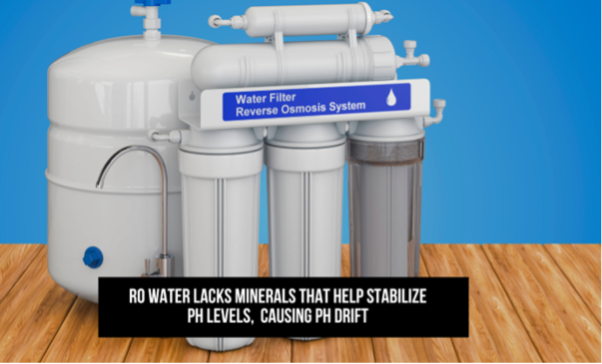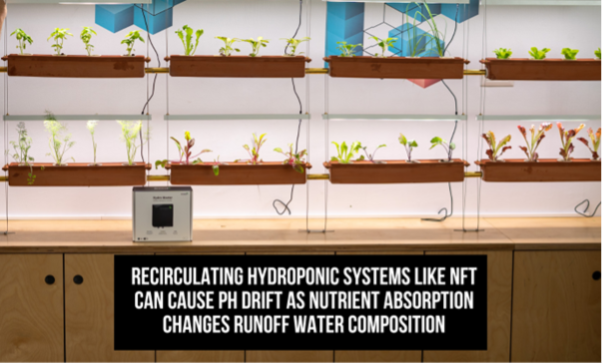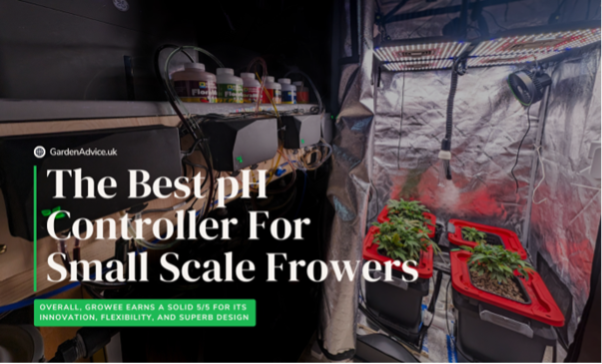Maintaining the correct pH levels in hydroponic systems is crucial for the health and growth of plants. One of the common challenges faced by growers is pH drifting. In this article, we will explore what pH drift is, why it occurs, and how it affects hydroponic systems. We will also discuss solutions to mitigate this issue and how they work.
What is pH Drift?
pH drift is when the pH level of the nutrient solution you use to feed your plants changes over time, usually within a few hours.
This is common in recirculating hydroponic systems such as DWC, NFT, Ebb and Flow, RDWC, and similar systems.
pH drift can happen in two ways: the pH can rise (for example, from 6.0 to 7.0) or fall (for example, from 6.0 to 5.0) in a short time. Sometimes, the pH can even fluctuate up and down over a short period, especially without a pH controller.
This makes it harder for your plants to absorb the nutrients they need.
Why Does pH Drift Happen?
Several factors contribute to pH drift in hydroponic systems:
- Nutrient Depletion: As plants absorb nutrients, the composition of the nutrient solution changes, which can cause pH levels to drift.
- Water Change: In systems where a lot of water is added frequently for refills, the new water can alter the pH over time.
- Microbial Activity: Beneficial and harmful microbes in the nutrient solution can produce byproducts that affect pH.
How Does Using RO Water in Hydroponic Systems Affect pH Drifting?
Using reverse osmosis (RO) water in hydroponic systems can affect pH drifting because RO water lacks minerals that help stabilize pH levels. In regular water, minerals like bicarbonates act as buffers, preventing sudden changes in pH.
However, RO water is filtered out of minerals and has no buffers, making the pH more likely to fluctuate when nutrients are added. This can cause the pH to drift over time, which can stress the plants. To prevent this, growers can mix a small amount of regular water with RO water. This step can help keep the pH stable, ensuring healthy plant growth.

Does the Type of Hydroponic Growing Method Affect pH Drifting?
Yes, the type of hydroponic growing method can affect pH drifting. In recirculating systems, the water is constantly in contact with the plant’s roots or the growing medium.
As plants absorb nutrients, the chemical composition of the runoff water changes. When this altered water returns to the main reservoir, it can shift the overall pH of the system. This makes pH management more challenging.
The most common recirculating hydroponic systems include Deep Water Culture (DWC), Nutrient Film Technique (NFT), Recirculating Deep Water Culture (RDWC), and Ebb and Flow systems.

Does Using a Float Valve in My System for Top Off Cause pH to Slowly Drift Up?
Yes, using a float valve in your hydroponic system for top-off can cause the pH to drift up slowly. When a float valve adds water to the system to maintain the water level, it typically adds plain water without nutrients. This dilutes the nutrient solution, often leading to an increase in pH over time.
The added water typically has a higher pH, usually between 7.5 and 8, compared to the nutrient solution, where most growers keep the pH in the 5.8 to 6.2 range. Adding water with a higher pH over time will gradually cause the overall pH of the solution to drift up.
Regular monitoring and adjusting of the pH can help manage this issue, ensuring optimal conditions for plant growth.
How Does pH Drifting Up Affect My Plants?
When the water pH in your hydroponic system drifts up, it can negatively impact your plants by affecting nutrient availability.
At higher pH levels, essential nutrients such as iron, manganese, and phosphorus become less soluble and less available for plant uptake. This can lead to nutrient deficiencies, even if those nutrients are present in the solution.
Symptoms of nutrient deficiencies include yellowing leaves, poor growth, and reduced yield. Therefore, maintaining the pH within the optimal range (typically 5.8 to 6.2 for most hydroponic systems) is crucial for ensuring that your plants can access all the nutrients they need.
How Does pH Drifting Down Affect My Plants?
When the pH in your hydroponic system drifts down, it can negatively impact your plants. At lower pH levels, essential nutrients like calcium and magnesium become less available, leading to deficiencies.
Additionally, low pH increases the solubility of toxic elements such as aluminum and manganese, which can harm plants.
Symptoms include stunted growth, dark green leaves, and root damage. Regularly monitoring and adjusting pH levels can help prevent these problems, ensuring a healthy environment for your plants to thrive.
Real-Life Use Case: How Low pH Can Benefit and Harm Your Hydroponic Plants
In a study published in HortScience, researchers investigated the effects of low pH on basil plants in hydroponic systems. They found that maintaining a nutrient solution pH at 4.0 effectively suppressed root rot caused by the pathogen Pythium aphanidermatum.
However, low pH also altered nutrient uptake, increasing concentrations of potassium and aluminum while decreasing levels of phosphorus, calcium, magnesium, sulfur, boron, manganese, and zinc in basil leaves.
This highlights the delicate balance required to manage pH levels in hydroponics. While low pH can help control certain diseases, it can also lead to nutrient imbalances and potential toxicity. Regular monitoring and careful adjustment of pH levels are essential to maintain optimal plant health and growth.
Practical Solutions to Prevent pH Drift
Keeping a stable pH level in your hydroponics doesn’t have to be complicated. However, the pH imbalance has to be addressed with urgency to optimize nutrient intake and prevent plant damage. That said, simple solutions present themselves in the following actions.
- Invest in a dual pH System: Deploy a pH controller, like the one offered by Growee, that features a smart algorithm for controlling both pH up and pH down adjustments, preventing drastic changes, and protecting plant roots from pH swings. This system continuously monitors pH levels and makes real-time adjustments, saving growers time and effort. Plus, you can track and adjust pH levels anywhere through its app.
- Use Up/Down pH solutions: These chemical additives balance the pH level by correcting any sudden increase or decrease. For slight adjustments, keep a solution available for quick use.
- Choose a reliable nutrient formula: Not all nutrient formulas are made equal. Unfortunately, they can impact the fluctuations in the pH levels. Go for nutrient formulas designed for hydroponics and make a habit of changing the reservoir every 1-2 weeks.
- Add organic buffers: If you’re aiming for a more natural approach in maintaining pH balance in your hydroponic system, opt for organic buffers like fulvic acid, humic acid, amino acids, and seaweed extract. These substances stabilize the pH of the nutrient solution, especially if acids and bases are added. They are derived from organic matters commonly found in decomposed plant and animal parts.
- Stabilize the temperature: Keep the temperature within 20-25oC. Higher temperatures can increase microbial activity that may cause pH swings.
- Prevent CO2 level elevation: Too much carbon dioxide can lower the pH level. Make sure to install proper ventilation in the hydroponic system and the room where the equipment is deployed to ensure proper air circulation.
Which solution fits you best will depend on your hydroponic setup and preferred level of convenience. Nonetheless, all actions require regular plant and environmental monitoring to ensure nothing goes under the radar—be it pH, CO2, or temperature inconsistencies.

Conclusion
pH drift is a common challenge in hydroponic systems, but with the right tools and knowledge, it can be effectively managed. For example, a pH controller offers an advanced solution, ensuring stable pH levels and promoting healthy plant growth. By understanding the causes of pH drift and utilizing reliable technology, growers can achieve better results in their hydroponic endeavors.
FAQs
What is pH Drift in Hydroponics?
pH drift refers to the gradual change in the pH level of your nutrient solution over time, which can impact plant health and nutrient absorption.
Why Does pH Drift Happen in Hydroponics?
Several factors contribute to pH drift, including nutrient depletion, water changes, and microbial activity in the nutrient solution.
How Does RO Water Affect pH Drifting in Hydroponics?
Using RO water can cause pH fluctuations because it lacks minerals that stabilize pH levels, making it more prone to changes when nutrients are added.
Does the Type of Hydroponic System Affect pH Drifting?
Yes, recirculating systems like DWC, NFT, RDWC, and Ebb and Flow are more prone to pH drift due to continuous nutrient solution changes.
Can a Float Valve Cause pH to Drift Up?
Yes, a float valve can cause pH to drift up by adding plain water with a higher pH, diluting the nutrient solution and raising its pH over time.
How Does pH Drifting Up Affect My Plants?
Rising pH levels can reduce the availability of essential nutrients like iron and manganese, leading to deficiencies and poor plant health.
How Does pH Drifting Down Affect My Plants?
Lower pH levels can limit the availability of nutrients such as calcium and magnesium and increase the solubility of harmful elements like aluminum.
How Can Low pH Both Benefit and Harm Hydroponic Plants?
Low pH can help control diseases like root rot but can also cause nutrient imbalances and potential toxicity, requiring careful monitoring and adjustment.
Recent Posts
- Smart Gardening: How GardenAI Helps Diagnose Tomato Plant Problems
- Selective Weed Control: What Kills Weeds But Not Plants in Your Vegetable Garden
- Sustainable Gardening: How to Create a Compost System That Works
- Heirloom Cherry Tomatoes: Cultivation Secrets for the Juiciest Tomatoes
- Fighting Frost: Practical Tips for Using Frost Blankets Effectively







